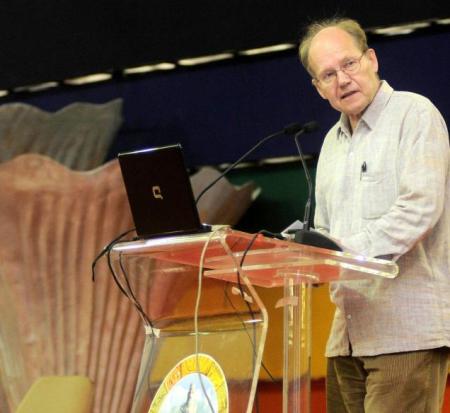Sanskrit has also contributed to Indus civilisation
http://www.deccanherald.com/content/79062/sanskrit-has-contributed-indus-civilisation.html
| Sanskrit has also contributed to Indus civilisation | |
| Saturday, July 03, 2010 | |
| Ancient civilisations and long un-deciphered mysterious scripts have always been hauntingly engaging challenges to the human consciousness. | |
 Fired by John Chadwick’s classic in archaeology, ‘The Decipherment of Linear-B’, that chronicles how the secrets of the late Minoan and Mycenaean civilisation in ancient Greece were unveiled, renowned Indologist Prof Asko Parpola set out on an equally challenging task over 45 years back to crack the script of the Indus Valley Civilisation. For someone who has done a lifetime of monumental research on ‘Deciphering the Indus Script’ even using modern computerised tools, Parpola, whose path-breaking study on ‘A Dravidian Solution to the Indus Script Problem’ had bagged the ‘Kalaignar M Karunanidhi Classical Tamil Research Award’ at the ‘World Classical Tamil Conference (WCTC)’ in Coimbatore, is remarkably self-effacing and realistic. A diligent scholar from Finland in both ‘Vedic’ and ‘Dravidian’ studies,spoke to M R Venkatesh of ‘Deccan Herald’. Fired by John Chadwick’s classic in archaeology, ‘The Decipherment of Linear-B’, that chronicles how the secrets of the late Minoan and Mycenaean civilisation in ancient Greece were unveiled, renowned Indologist Prof Asko Parpola set out on an equally challenging task over 45 years back to crack the script of the Indus Valley Civilisation. For someone who has done a lifetime of monumental research on ‘Deciphering the Indus Script’ even using modern computerised tools, Parpola, whose path-breaking study on ‘A Dravidian Solution to the Indus Script Problem’ had bagged the ‘Kalaignar M Karunanidhi Classical Tamil Research Award’ at the ‘World Classical Tamil Conference (WCTC)’ in Coimbatore, is remarkably self-effacing and realistic. A diligent scholar from Finland in both ‘Vedic’ and ‘Dravidian’ studies,spoke to M R Venkatesh of ‘Deccan Herald’.Excerpts:
What prompted you to undertake this amazing intellectual journey? Well, my interest in the Indus Script was aroused during my student years. I also studied the classical languages of Europe, Greek and Latin, when I became a student of Helsinki University in 1959. At that time there was much discussion whether the ‘Linear-B Script’ had been deciphered or not. Actually it had been deciphered in 1952. A book on it by John Chadwick came out in 1960. I read it and it was quite fascinating. I was quite convinced that this (decipherment) is correct though there were still some Greek scholars who were sceptical. And then, my childhood friend Seppo Koskenniemi who was working for IBM in Finland asked if I would like to try computers for any problem in my field. He volunteered to do the programming; so at that time I thought we might do something useful to promote the study of the Indus Script. Because compiling statistics (on the frequency with which signs are repeated, etc.) has been very useful in all decipherment How did you use computer technology in this study of Indus Script as India’s renowned epigraphist, Iravadham Mahadevan says you are the first person to have done it? On your seminal work on the Indus Script, what effected your change of approach to include sociology, anthropology and linguistics, instead of just an epigraphist approach that failed to make headway earlier? Your solution to the Indus Script riddle – that the underlying s a syncretism rather than a collusive view of Indo-Aryan and the Dravidian family of languages. Your comments please? One of 20th century’s greatest philosophers Wittgenstein had said understanding a language is understanding a whole form of life. Has your findings on Indus Script vindicated that insight on how language works? But these linguistic identities, when politicised, could lead to all kinds of disastrous consequences. So how is a harmonious understanding of world languages possible? Your next project: will you continue your work on the Indus script? How do you see the WCTC’s significance? Has it provided a platform to take forward your work on the Indus script? | |





